Mobile Physician Documentation: Concept Development for Hospitals
VerifiedAdded on 2020/05/04
|24
|5919
|76
Report
AI Summary
This report delves into the concept of mobile documentation for physicians in hospitals, addressing the inefficiencies of current documentation processes. It begins by assessing the existing methods, including who is responsible, the various processes involved (medical records, physical examinations, emergency reports, etc.), and the timing of documentation. The study then explores the possibilities of optimization through mobile documentation, identifying current challenges and proposing modifications such as the implementation of Electronic Health Records (EHRs). The core of the report outlines a concept for mobile documentation, covering initial visits, subsequent visits, data transfer, and security considerations. The aim is to reduce the time physicians spend on documentation, allowing them to focus more on patient care, while also improving data accuracy and accessibility. The report emphasizes the importance of a user-friendly system and collaboration among healthcare organizations to achieve these goals.
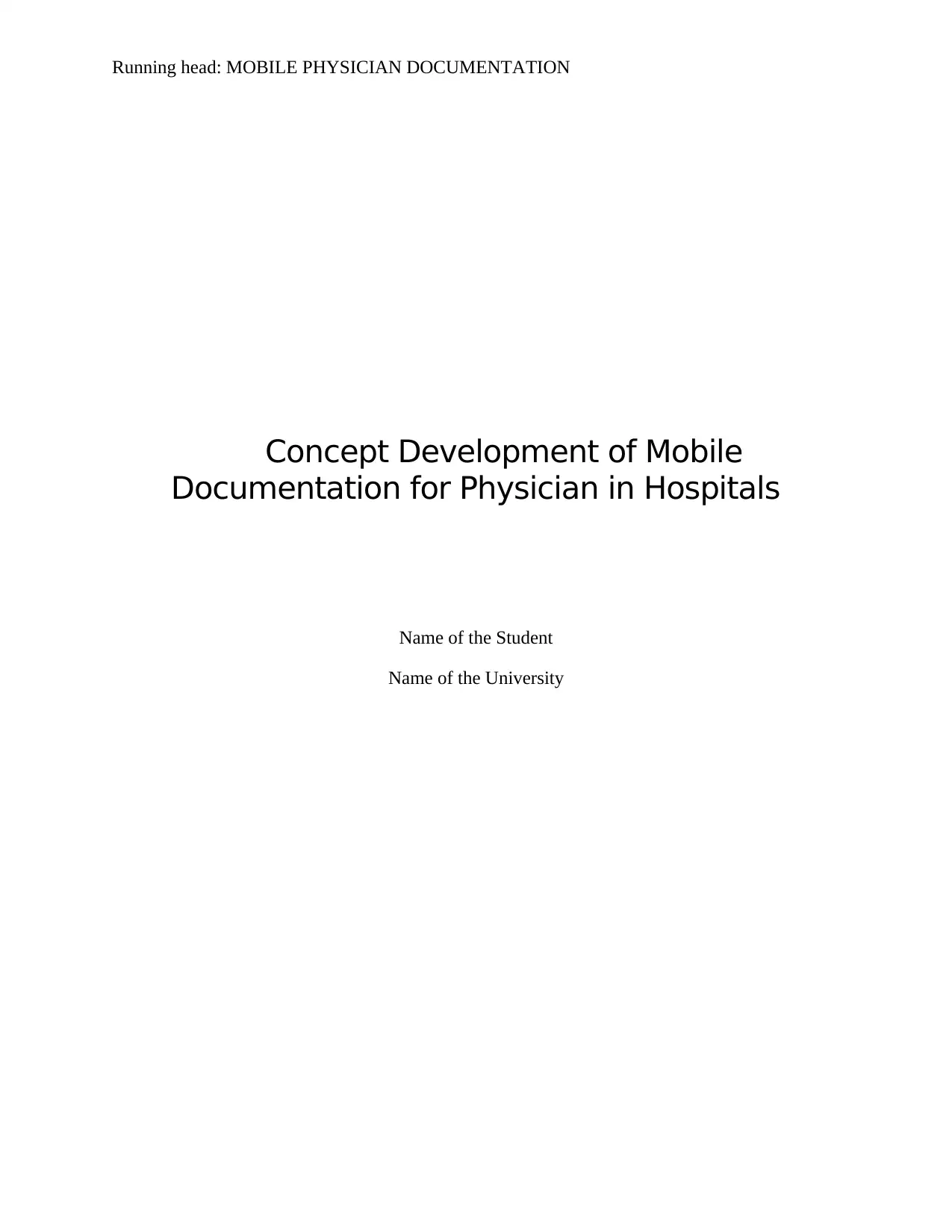
Running head: MOBILE PHYSICIAN DOCUMENTATION
Concept Development of Mobile
Documentation for Physician in Hospitals
Name of the Student
Name of the University
Concept Development of Mobile
Documentation for Physician in Hospitals
Name of the Student
Name of the University
Paraphrase This Document
Need a fresh take? Get an instant paraphrase of this document with our AI Paraphraser
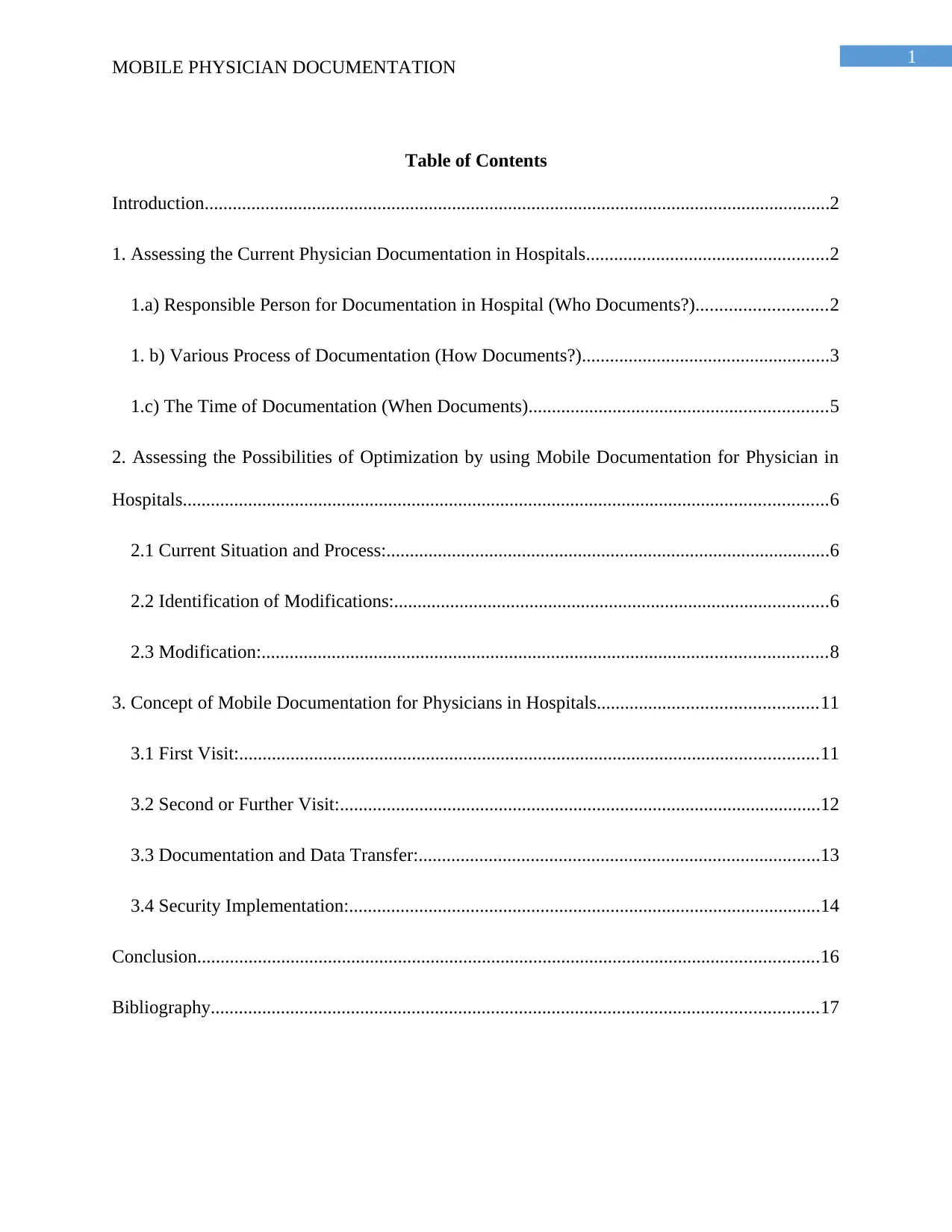
1
MOBILE PHYSICIAN DOCUMENTATION
Table of Contents
Introduction......................................................................................................................................2
1. Assessing the Current Physician Documentation in Hospitals....................................................2
1.a) Responsible Person for Documentation in Hospital (Who Documents?)............................2
1. b) Various Process of Documentation (How Documents?).....................................................3
1.c) The Time of Documentation (When Documents)................................................................5
2. Assessing the Possibilities of Optimization by using Mobile Documentation for Physician in
Hospitals..........................................................................................................................................6
2.1 Current Situation and Process:...............................................................................................6
2.2 Identification of Modifications:.............................................................................................6
2.3 Modification:.........................................................................................................................8
3. Concept of Mobile Documentation for Physicians in Hospitals...............................................11
3.1 First Visit:............................................................................................................................11
3.2 Second or Further Visit:.......................................................................................................12
3.3 Documentation and Data Transfer:......................................................................................13
3.4 Security Implementation:.....................................................................................................14
Conclusion.....................................................................................................................................16
Bibliography..................................................................................................................................17
MOBILE PHYSICIAN DOCUMENTATION
Table of Contents
Introduction......................................................................................................................................2
1. Assessing the Current Physician Documentation in Hospitals....................................................2
1.a) Responsible Person for Documentation in Hospital (Who Documents?)............................2
1. b) Various Process of Documentation (How Documents?).....................................................3
1.c) The Time of Documentation (When Documents)................................................................5
2. Assessing the Possibilities of Optimization by using Mobile Documentation for Physician in
Hospitals..........................................................................................................................................6
2.1 Current Situation and Process:...............................................................................................6
2.2 Identification of Modifications:.............................................................................................6
2.3 Modification:.........................................................................................................................8
3. Concept of Mobile Documentation for Physicians in Hospitals...............................................11
3.1 First Visit:............................................................................................................................11
3.2 Second or Further Visit:.......................................................................................................12
3.3 Documentation and Data Transfer:......................................................................................13
3.4 Security Implementation:.....................................................................................................14
Conclusion.....................................................................................................................................16
Bibliography..................................................................................................................................17

2
MOBILE PHYSICIAN DOCUMENTATION
MOBILE PHYSICIAN DOCUMENTATION
⊘ This is a preview!⊘
Do you want full access?
Subscribe today to unlock all pages.

Trusted by 1+ million students worldwide

3
MOBILE PHYSICIAN DOCUMENTATION
Introduction
This study aims to provide information about the needs and important of mobile
documentation for Physician in hospitals. It has been observed that physician in hospitals are
spending more time in preparing documentation rather than take direct care of the patients.
Therefore, this study provides the outline of current documentation process of hospitals by
physician and the possibilities of assessing mobile documentation in their process along with the
develop concept and security issues.
1. Assessing the Current Physician Documentation in Hospitals
Documentation of medical record is an important requirement of every hospital. It is
required for the purpose of recording pertinent facts, observations and findings about a patient’s
health history (Blair & Smith, 2012). It documents the details of the present and past illnesses,
treatments and tests of the patients. Health documents play a significant role in contributing to
the quality of patient care that is carried out in the hospitals.
1.a) Responsible Person for Documentation in Hospital (Who Documents?)
The physicians are responsible for documenting the medical history of the patients that
will contain evidences of the physical examinations (Calloway, Akilo & Bierman, 2013).
Physicians spend most of their time in documenting about the diagnosis, treatments, procedures
and investigations for every treatment that is carried out (Timimi, 2012). The physicians are also
responsible for documenting the medical management plan of the hospital. Copies of certificates
that are provided to the patients are also documented by the physicians.
MOBILE PHYSICIAN DOCUMENTATION
Introduction
This study aims to provide information about the needs and important of mobile
documentation for Physician in hospitals. It has been observed that physician in hospitals are
spending more time in preparing documentation rather than take direct care of the patients.
Therefore, this study provides the outline of current documentation process of hospitals by
physician and the possibilities of assessing mobile documentation in their process along with the
develop concept and security issues.
1. Assessing the Current Physician Documentation in Hospitals
Documentation of medical record is an important requirement of every hospital. It is
required for the purpose of recording pertinent facts, observations and findings about a patient’s
health history (Blair & Smith, 2012). It documents the details of the present and past illnesses,
treatments and tests of the patients. Health documents play a significant role in contributing to
the quality of patient care that is carried out in the hospitals.
1.a) Responsible Person for Documentation in Hospital (Who Documents?)
The physicians are responsible for documenting the medical history of the patients that
will contain evidences of the physical examinations (Calloway, Akilo & Bierman, 2013).
Physicians spend most of their time in documenting about the diagnosis, treatments, procedures
and investigations for every treatment that is carried out (Timimi, 2012). The physicians are also
responsible for documenting the medical management plan of the hospital. Copies of certificates
that are provided to the patients are also documented by the physicians.
Paraphrase This Document
Need a fresh take? Get an instant paraphrase of this document with our AI Paraphraser

4
MOBILE PHYSICIAN DOCUMENTATION
1. b) Various Process of Documentation (How Documents?)
In the hospitals, there are several types of documentation that taken place. These are the
followings -
A) Medical Record: This record consists of the patient details along with diagnosis
details. It contains the result of treatments so that it facilitates future care of the patients. The
medical practitioner is responsible for maintaining the medical records of the patients and for
regular updates so that appropriate care of the patients can be carried out in the hospital
(Devkaran &O'Farrell, 2014). This record is documented from the time when the patient is
admitted to the hospital till the time of discharge. It is updated on a regular basis by the
physicians and medical practitioners (Haux et al., 2013). The medical record is generally
documented manually by the physicians present in the hospital.
B) Physical Examinations and History Record: It is the responsibility of the physicians
or Allied Health Professionals to perform physical examinations and admission history of the
patients (Swartz, 2014). This H&P record must be completely updated before any surgery or
other invasive procedures. It contains information about the present illness, past medical details,
physical examinations and its results. It also contains the action plan that needs to be carried out
for carrying out the treatment of the patients. Documentation procedure is carried out manually
in the hospitals.
Consider a situation when complete history of the patient is not documented before the
surgery. In this case, the surgeon needs to first complete the documentation procedure before
carrying out the operation. Invasive procedures like OR procedures, endoscopies, tubal ligations
and ambulatory surgeries must include H&P record (Williams et al., 2014). Attending medical
MOBILE PHYSICIAN DOCUMENTATION
1. b) Various Process of Documentation (How Documents?)
In the hospitals, there are several types of documentation that taken place. These are the
followings -
A) Medical Record: This record consists of the patient details along with diagnosis
details. It contains the result of treatments so that it facilitates future care of the patients. The
medical practitioner is responsible for maintaining the medical records of the patients and for
regular updates so that appropriate care of the patients can be carried out in the hospital
(Devkaran &O'Farrell, 2014). This record is documented from the time when the patient is
admitted to the hospital till the time of discharge. It is updated on a regular basis by the
physicians and medical practitioners (Haux et al., 2013). The medical record is generally
documented manually by the physicians present in the hospital.
B) Physical Examinations and History Record: It is the responsibility of the physicians
or Allied Health Professionals to perform physical examinations and admission history of the
patients (Swartz, 2014). This H&P record must be completely updated before any surgery or
other invasive procedures. It contains information about the present illness, past medical details,
physical examinations and its results. It also contains the action plan that needs to be carried out
for carrying out the treatment of the patients. Documentation procedure is carried out manually
in the hospitals.
Consider a situation when complete history of the patient is not documented before the
surgery. In this case, the surgeon needs to first complete the documentation procedure before
carrying out the operation. Invasive procedures like OR procedures, endoscopies, tubal ligations
and ambulatory surgeries must include H&P record (Williams et al., 2014). Attending medical

5
MOBILE PHYSICIAN DOCUMENTATION
staffs and physicians are mainly responsible for documentation of H&P. It needs to be updated
on a regular basis by the physicians (Johnson et al., 2014). Dentists are responsible for their
patient’s H&P that is related to dentistry. In case of ambulatory surgical patients, this document
must contain list of the current medications and other essential information of the patients.
C) Report of the Emergency Department: This report contains time of arrival of the
patient, clinical observations, results of treatment, and patient’s condition at the time of
discharge, and history regarding the illness along with its physical findings (Taubman et al.,
2014). It will also consist of the details of final disposition, instructions for the purpose of
follow-up care and treatments. The medical practitioners and physicians who are handling the
emergency departments are responsible for carrying out this documentation procedure. The
physicians make sure that this emergency record is accurate so that they can analyze this case in
the future and further help the patients to recover in an effective manner (Ward et al., 2014). This
record is maintained in a file and the information is recorded manually.
D)Progress Report: This document will contain the progress report of the patients.
Handwritten notes are used by most of the hospitals for recording the daily health progress of the
patients. It will help to provide the health record of the patients in a chronological order. It will
help to provide details about the change in the health condition of the patients.
E) Operative Report: This type of report is documented after the completion of an
operative or high risk procedure before transferring the patient to the next level of treatment and
care (Mamykina et al., 2012). Operative reports are prepared and documented by the surgeons
who carry out the operations and high risk procedures.
MOBILE PHYSICIAN DOCUMENTATION
staffs and physicians are mainly responsible for documentation of H&P. It needs to be updated
on a regular basis by the physicians (Johnson et al., 2014). Dentists are responsible for their
patient’s H&P that is related to dentistry. In case of ambulatory surgical patients, this document
must contain list of the current medications and other essential information of the patients.
C) Report of the Emergency Department: This report contains time of arrival of the
patient, clinical observations, results of treatment, and patient’s condition at the time of
discharge, and history regarding the illness along with its physical findings (Taubman et al.,
2014). It will also consist of the details of final disposition, instructions for the purpose of
follow-up care and treatments. The medical practitioners and physicians who are handling the
emergency departments are responsible for carrying out this documentation procedure. The
physicians make sure that this emergency record is accurate so that they can analyze this case in
the future and further help the patients to recover in an effective manner (Ward et al., 2014). This
record is maintained in a file and the information is recorded manually.
D)Progress Report: This document will contain the progress report of the patients.
Handwritten notes are used by most of the hospitals for recording the daily health progress of the
patients. It will help to provide the health record of the patients in a chronological order. It will
help to provide details about the change in the health condition of the patients.
E) Operative Report: This type of report is documented after the completion of an
operative or high risk procedure before transferring the patient to the next level of treatment and
care (Mamykina et al., 2012). Operative reports are prepared and documented by the surgeons
who carry out the operations and high risk procedures.
⊘ This is a preview!⊘
Do you want full access?
Subscribe today to unlock all pages.

Trusted by 1+ million students worldwide

6
MOBILE PHYSICIAN DOCUMENTATION
F) Discharge Summary: This is a document that contains information regarding the
reason for admission of the patient, summary of the diagnosis, patient’s condition and the
instructions that are given to the patient about further diet and medication (Pollard et al., 2013).
The discharge summary of the patients needs to be documented within 24 hours after the
discharge has taken place (Lenert, Sakaguchi & Weir, 2014). This documentation is carried out
by the practitioner who was responsible for the medication of the patient.
G)Transfer Summary: This report needs to be documented when patients are transferred
from one unit to another unit for the purpose of further treatment and care. The transferring
physician is responsible for carrying out the documentation of the transfer summary. The transfer
summary will contain details about the reason for the transfer, summary of the treatments, cares
and services that are provided to the patients. It will also contain details about the progress of the
health of the patient and the risks or benefits for transferring the patient to another unit or
hospital. The transfer summary can act like a guide to the next physician who will be responsible
for the patient’s treatment and medications (Gregory &Radovinsky, 2012). It will also contain
the psychosocial and physical status of the patient. This document is present in the form of files
that is manually completed by the physician.
1.c) The Time of Documentation (When Documents)
Physicians generally document the medical details of the patients after examining the
health condition of the patients. Sometimes the health history of the patients is also recorded by
the physicians. The physical examination and health history of the patients are documented in the
medical record of the patients within 24 hours from the time of admission or during the time of
registration. Emergency report needs to be completed within 1 day or approximately 24 hours
from the time of discharge or disposition of the patient from the emergency department of the
MOBILE PHYSICIAN DOCUMENTATION
F) Discharge Summary: This is a document that contains information regarding the
reason for admission of the patient, summary of the diagnosis, patient’s condition and the
instructions that are given to the patient about further diet and medication (Pollard et al., 2013).
The discharge summary of the patients needs to be documented within 24 hours after the
discharge has taken place (Lenert, Sakaguchi & Weir, 2014). This documentation is carried out
by the practitioner who was responsible for the medication of the patient.
G)Transfer Summary: This report needs to be documented when patients are transferred
from one unit to another unit for the purpose of further treatment and care. The transferring
physician is responsible for carrying out the documentation of the transfer summary. The transfer
summary will contain details about the reason for the transfer, summary of the treatments, cares
and services that are provided to the patients. It will also contain details about the progress of the
health of the patient and the risks or benefits for transferring the patient to another unit or
hospital. The transfer summary can act like a guide to the next physician who will be responsible
for the patient’s treatment and medications (Gregory &Radovinsky, 2012). It will also contain
the psychosocial and physical status of the patient. This document is present in the form of files
that is manually completed by the physician.
1.c) The Time of Documentation (When Documents)
Physicians generally document the medical details of the patients after examining the
health condition of the patients. Sometimes the health history of the patients is also recorded by
the physicians. The physical examination and health history of the patients are documented in the
medical record of the patients within 24 hours from the time of admission or during the time of
registration. Emergency report needs to be completed within 1 day or approximately 24 hours
from the time of discharge or disposition of the patient from the emergency department of the
Paraphrase This Document
Need a fresh take? Get an instant paraphrase of this document with our AI Paraphraser
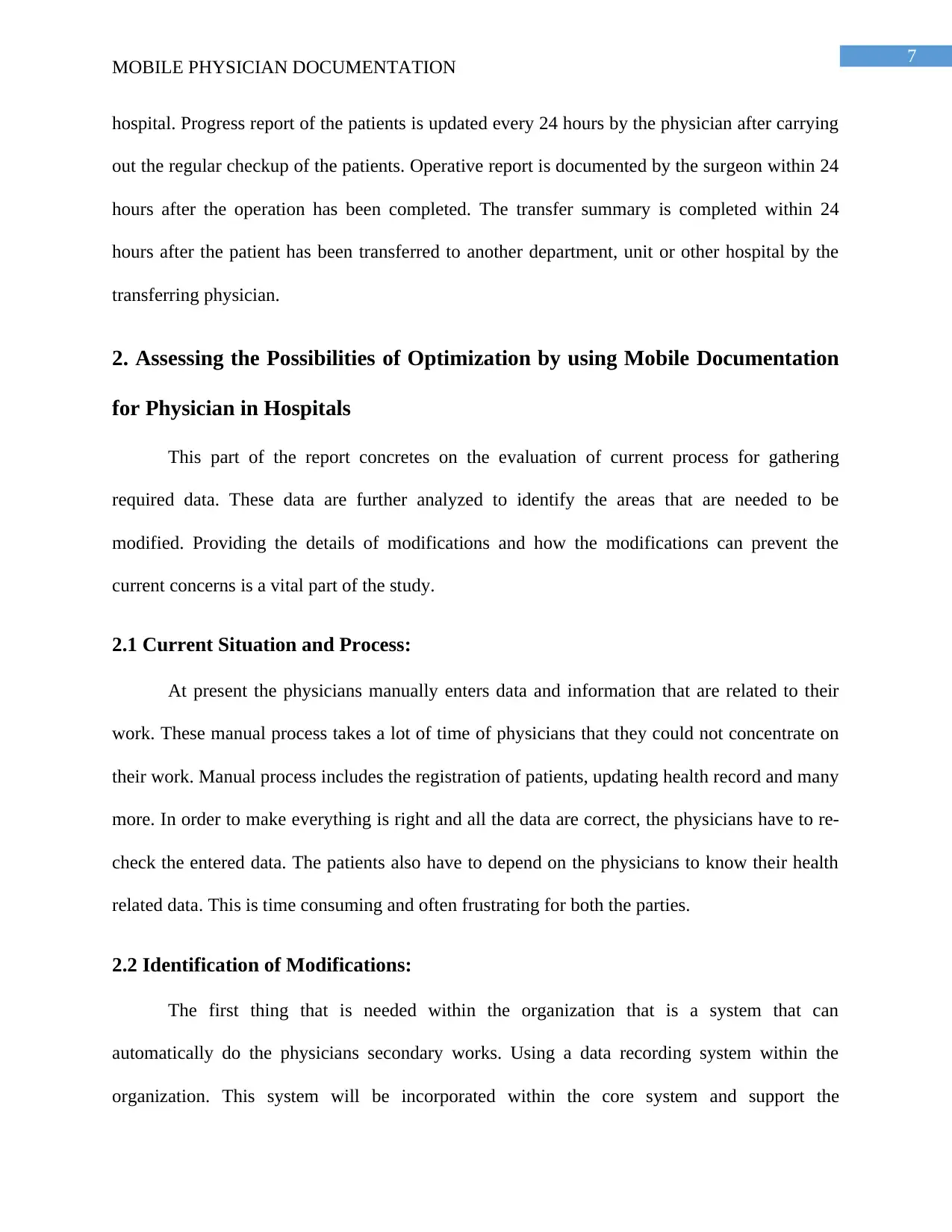
7
MOBILE PHYSICIAN DOCUMENTATION
hospital. Progress report of the patients is updated every 24 hours by the physician after carrying
out the regular checkup of the patients. Operative report is documented by the surgeon within 24
hours after the operation has been completed. The transfer summary is completed within 24
hours after the patient has been transferred to another department, unit or other hospital by the
transferring physician.
2. Assessing the Possibilities of Optimization by using Mobile Documentation
for Physician in Hospitals
This part of the report concretes on the evaluation of current process for gathering
required data. These data are further analyzed to identify the areas that are needed to be
modified. Providing the details of modifications and how the modifications can prevent the
current concerns is a vital part of the study.
2.1 Current Situation and Process:
At present the physicians manually enters data and information that are related to their
work. These manual process takes a lot of time of physicians that they could not concentrate on
their work. Manual process includes the registration of patients, updating health record and many
more. In order to make everything is right and all the data are correct, the physicians have to re-
check the entered data. The patients also have to depend on the physicians to know their health
related data. This is time consuming and often frustrating for both the parties.
2.2 Identification of Modifications:
The first thing that is needed within the organization that is a system that can
automatically do the physicians secondary works. Using a data recording system within the
organization. This system will be incorporated within the core system and support the
MOBILE PHYSICIAN DOCUMENTATION
hospital. Progress report of the patients is updated every 24 hours by the physician after carrying
out the regular checkup of the patients. Operative report is documented by the surgeon within 24
hours after the operation has been completed. The transfer summary is completed within 24
hours after the patient has been transferred to another department, unit or other hospital by the
transferring physician.
2. Assessing the Possibilities of Optimization by using Mobile Documentation
for Physician in Hospitals
This part of the report concretes on the evaluation of current process for gathering
required data. These data are further analyzed to identify the areas that are needed to be
modified. Providing the details of modifications and how the modifications can prevent the
current concerns is a vital part of the study.
2.1 Current Situation and Process:
At present the physicians manually enters data and information that are related to their
work. These manual process takes a lot of time of physicians that they could not concentrate on
their work. Manual process includes the registration of patients, updating health record and many
more. In order to make everything is right and all the data are correct, the physicians have to re-
check the entered data. The patients also have to depend on the physicians to know their health
related data. This is time consuming and often frustrating for both the parties.
2.2 Identification of Modifications:
The first thing that is needed within the organization that is a system that can
automatically do the physicians secondary works. Using a data recording system within the
organization. This system will be incorporated within the core system and support the

8
MOBILE PHYSICIAN DOCUMENTATION
organization objective. The system must be able to provide accurate and efficient search option
to the physicians. The system must be able to store all the personal and health related data of the
patients. As an enormous amount of data will be stored within the system, the functionalities and
features of the data recording system must be able to cope with the changing needs. As the first
priority is reducing the time of work of physicians and let then concentrate on patient care, the
system must be able to provide all the required data to the patients in real time.
The healthcare organizations also focus on including the patients within the picture. The
patients must be able to help themselves to gather their updated health record and enter required
data. It becomes often difficult for the physicians to register the patients within the system and
treatment them at the same time, especially at the time when patients are present in large number.
The registration process becomes very lengthy that it affects the main purpose of the physicians.
The proposed system must be able to assist the physicians to reduce the time of documentation
through giving the patients the responsibility of registration into the system. For this purpose, the
healthcare organization must develop a technology that can be user friendly and accessible by
anyone. The application will be connected to the main sever and database. Therefore, it will be
possible for the patients to gather health data efficiently, without asking anyone.
Another modification that is needed within the healthcare organizations is the
collaborations among them. This will be a huge step toward reducing the documentation time of
the physicians and increasing the affectivity and efficiency of patient treatment. For this a shared
system or server or any other advanced technology can be used. This technology will be
assisting the physicians to gather the data regarding the patients and their treatment history from
other healthcare.
MOBILE PHYSICIAN DOCUMENTATION
organization objective. The system must be able to provide accurate and efficient search option
to the physicians. The system must be able to store all the personal and health related data of the
patients. As an enormous amount of data will be stored within the system, the functionalities and
features of the data recording system must be able to cope with the changing needs. As the first
priority is reducing the time of work of physicians and let then concentrate on patient care, the
system must be able to provide all the required data to the patients in real time.
The healthcare organizations also focus on including the patients within the picture. The
patients must be able to help themselves to gather their updated health record and enter required
data. It becomes often difficult for the physicians to register the patients within the system and
treatment them at the same time, especially at the time when patients are present in large number.
The registration process becomes very lengthy that it affects the main purpose of the physicians.
The proposed system must be able to assist the physicians to reduce the time of documentation
through giving the patients the responsibility of registration into the system. For this purpose, the
healthcare organization must develop a technology that can be user friendly and accessible by
anyone. The application will be connected to the main sever and database. Therefore, it will be
possible for the patients to gather health data efficiently, without asking anyone.
Another modification that is needed within the healthcare organizations is the
collaborations among them. This will be a huge step toward reducing the documentation time of
the physicians and increasing the affectivity and efficiency of patient treatment. For this a shared
system or server or any other advanced technology can be used. This technology will be
assisting the physicians to gather the data regarding the patients and their treatment history from
other healthcare.
⊘ This is a preview!⊘
Do you want full access?
Subscribe today to unlock all pages.

Trusted by 1+ million students worldwide
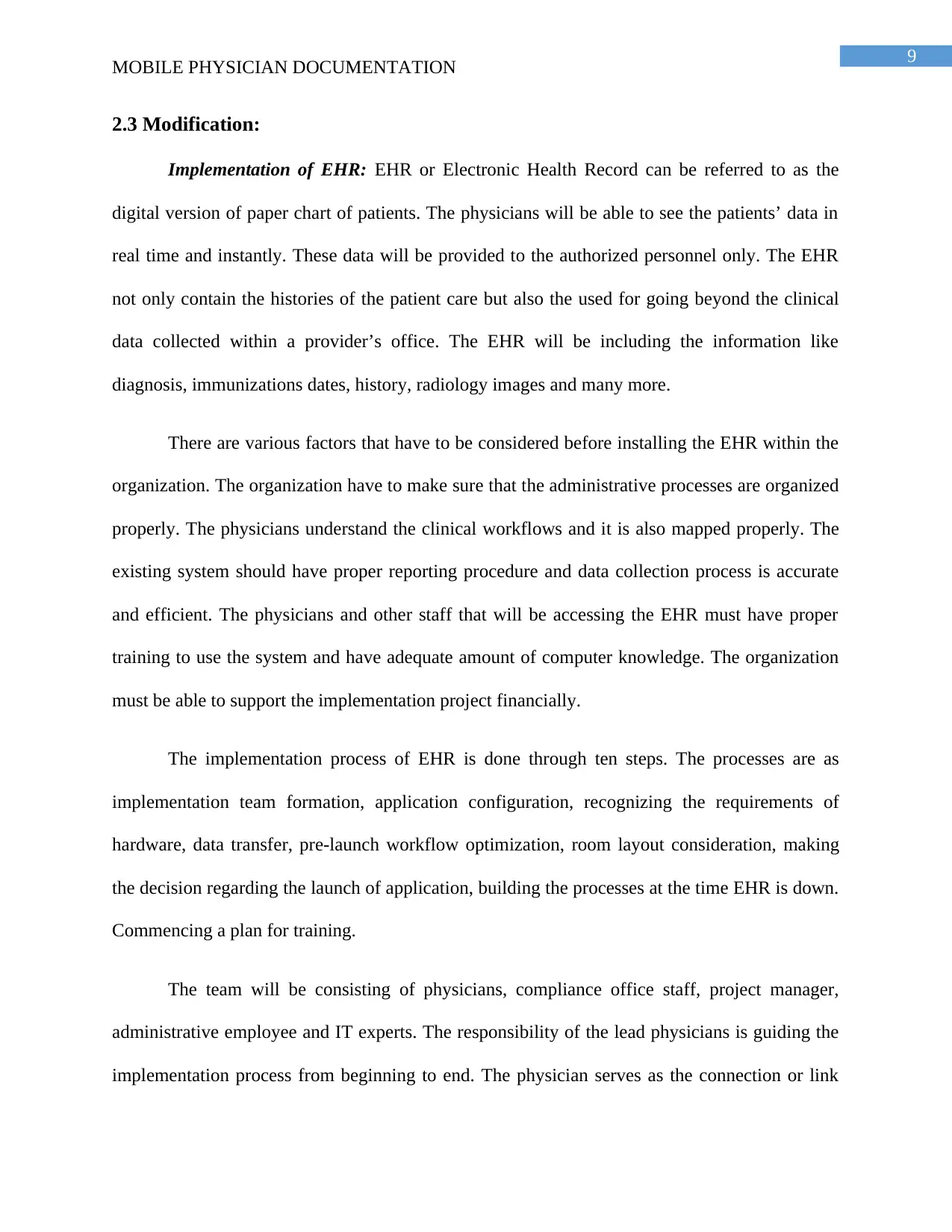
9
MOBILE PHYSICIAN DOCUMENTATION
2.3 Modification:
Implementation of EHR: EHR or Electronic Health Record can be referred to as the
digital version of paper chart of patients. The physicians will be able to see the patients’ data in
real time and instantly. These data will be provided to the authorized personnel only. The EHR
not only contain the histories of the patient care but also the used for going beyond the clinical
data collected within a provider’s office. The EHR will be including the information like
diagnosis, immunizations dates, history, radiology images and many more.
There are various factors that have to be considered before installing the EHR within the
organization. The organization have to make sure that the administrative processes are organized
properly. The physicians understand the clinical workflows and it is also mapped properly. The
existing system should have proper reporting procedure and data collection process is accurate
and efficient. The physicians and other staff that will be accessing the EHR must have proper
training to use the system and have adequate amount of computer knowledge. The organization
must be able to support the implementation project financially.
The implementation process of EHR is done through ten steps. The processes are as
implementation team formation, application configuration, recognizing the requirements of
hardware, data transfer, pre-launch workflow optimization, room layout consideration, making
the decision regarding the launch of application, building the processes at the time EHR is down.
Commencing a plan for training.
The team will be consisting of physicians, compliance office staff, project manager,
administrative employee and IT experts. The responsibility of the lead physicians is guiding the
implementation process from beginning to end. The physician serves as the connection or link
MOBILE PHYSICIAN DOCUMENTATION
2.3 Modification:
Implementation of EHR: EHR or Electronic Health Record can be referred to as the
digital version of paper chart of patients. The physicians will be able to see the patients’ data in
real time and instantly. These data will be provided to the authorized personnel only. The EHR
not only contain the histories of the patient care but also the used for going beyond the clinical
data collected within a provider’s office. The EHR will be including the information like
diagnosis, immunizations dates, history, radiology images and many more.
There are various factors that have to be considered before installing the EHR within the
organization. The organization have to make sure that the administrative processes are organized
properly. The physicians understand the clinical workflows and it is also mapped properly. The
existing system should have proper reporting procedure and data collection process is accurate
and efficient. The physicians and other staff that will be accessing the EHR must have proper
training to use the system and have adequate amount of computer knowledge. The organization
must be able to support the implementation project financially.
The implementation process of EHR is done through ten steps. The processes are as
implementation team formation, application configuration, recognizing the requirements of
hardware, data transfer, pre-launch workflow optimization, room layout consideration, making
the decision regarding the launch of application, building the processes at the time EHR is down.
Commencing a plan for training.
The team will be consisting of physicians, compliance office staff, project manager,
administrative employee and IT experts. The responsibility of the lead physicians is guiding the
implementation process from beginning to end. The physician serves as the connection or link
Paraphrase This Document
Need a fresh take? Get an instant paraphrase of this document with our AI Paraphraser
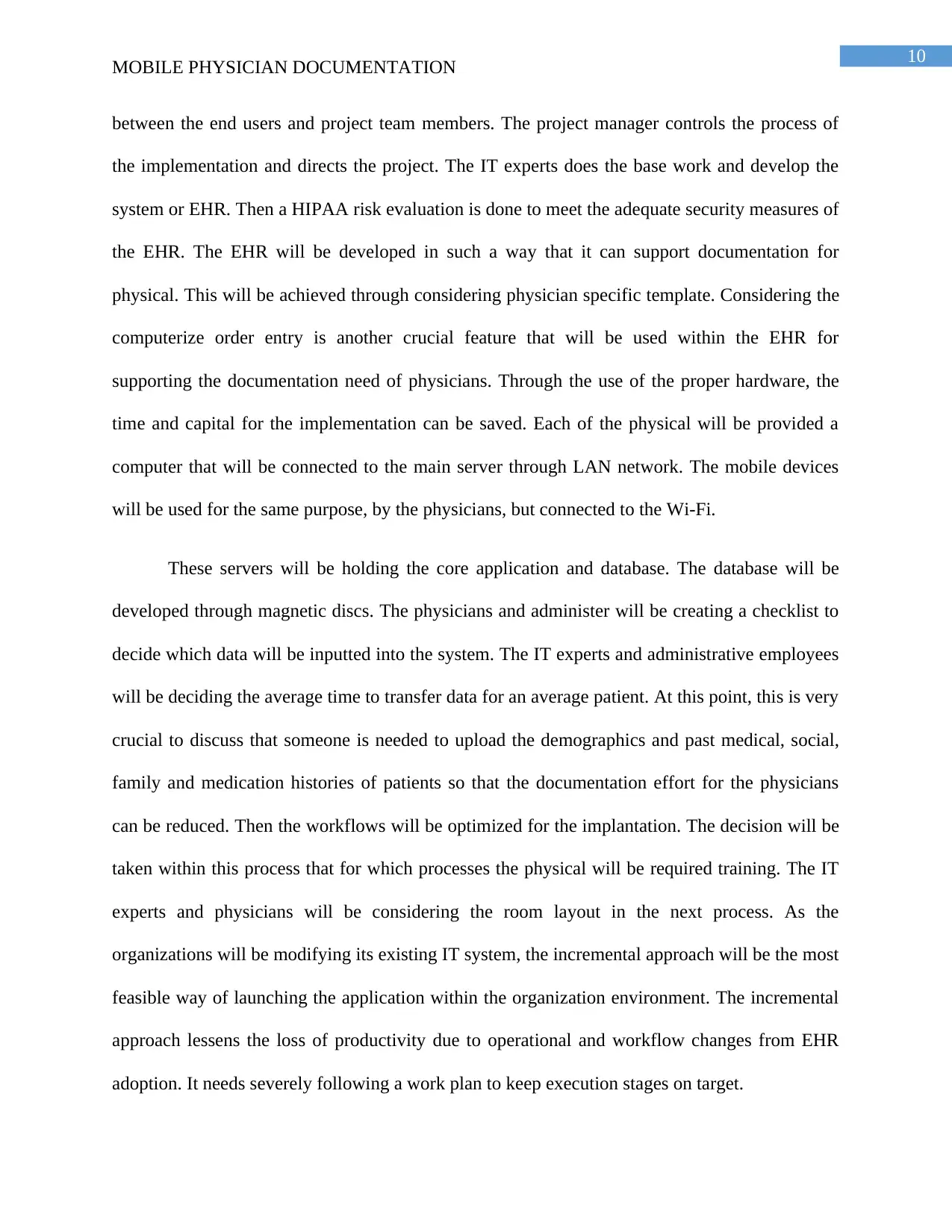
10
MOBILE PHYSICIAN DOCUMENTATION
between the end users and project team members. The project manager controls the process of
the implementation and directs the project. The IT experts does the base work and develop the
system or EHR. Then a HIPAA risk evaluation is done to meet the adequate security measures of
the EHR. The EHR will be developed in such a way that it can support documentation for
physical. This will be achieved through considering physician specific template. Considering the
computerize order entry is another crucial feature that will be used within the EHR for
supporting the documentation need of physicians. Through the use of the proper hardware, the
time and capital for the implementation can be saved. Each of the physical will be provided a
computer that will be connected to the main server through LAN network. The mobile devices
will be used for the same purpose, by the physicians, but connected to the Wi-Fi.
These servers will be holding the core application and database. The database will be
developed through magnetic discs. The physicians and administer will be creating a checklist to
decide which data will be inputted into the system. The IT experts and administrative employees
will be deciding the average time to transfer data for an average patient. At this point, this is very
crucial to discuss that someone is needed to upload the demographics and past medical, social,
family and medication histories of patients so that the documentation effort for the physicians
can be reduced. Then the workflows will be optimized for the implantation. The decision will be
taken within this process that for which processes the physical will be required training. The IT
experts and physicians will be considering the room layout in the next process. As the
organizations will be modifying its existing IT system, the incremental approach will be the most
feasible way of launching the application within the organization environment. The incremental
approach lessens the loss of productivity due to operational and workflow changes from EHR
adoption. It needs severely following a work plan to keep execution stages on target.
MOBILE PHYSICIAN DOCUMENTATION
between the end users and project team members. The project manager controls the process of
the implementation and directs the project. The IT experts does the base work and develop the
system or EHR. Then a HIPAA risk evaluation is done to meet the adequate security measures of
the EHR. The EHR will be developed in such a way that it can support documentation for
physical. This will be achieved through considering physician specific template. Considering the
computerize order entry is another crucial feature that will be used within the EHR for
supporting the documentation need of physicians. Through the use of the proper hardware, the
time and capital for the implementation can be saved. Each of the physical will be provided a
computer that will be connected to the main server through LAN network. The mobile devices
will be used for the same purpose, by the physicians, but connected to the Wi-Fi.
These servers will be holding the core application and database. The database will be
developed through magnetic discs. The physicians and administer will be creating a checklist to
decide which data will be inputted into the system. The IT experts and administrative employees
will be deciding the average time to transfer data for an average patient. At this point, this is very
crucial to discuss that someone is needed to upload the demographics and past medical, social,
family and medication histories of patients so that the documentation effort for the physicians
can be reduced. Then the workflows will be optimized for the implantation. The decision will be
taken within this process that for which processes the physical will be required training. The IT
experts and physicians will be considering the room layout in the next process. As the
organizations will be modifying its existing IT system, the incremental approach will be the most
feasible way of launching the application within the organization environment. The incremental
approach lessens the loss of productivity due to operational and workflow changes from EHR
adoption. It needs severely following a work plan to keep execution stages on target.
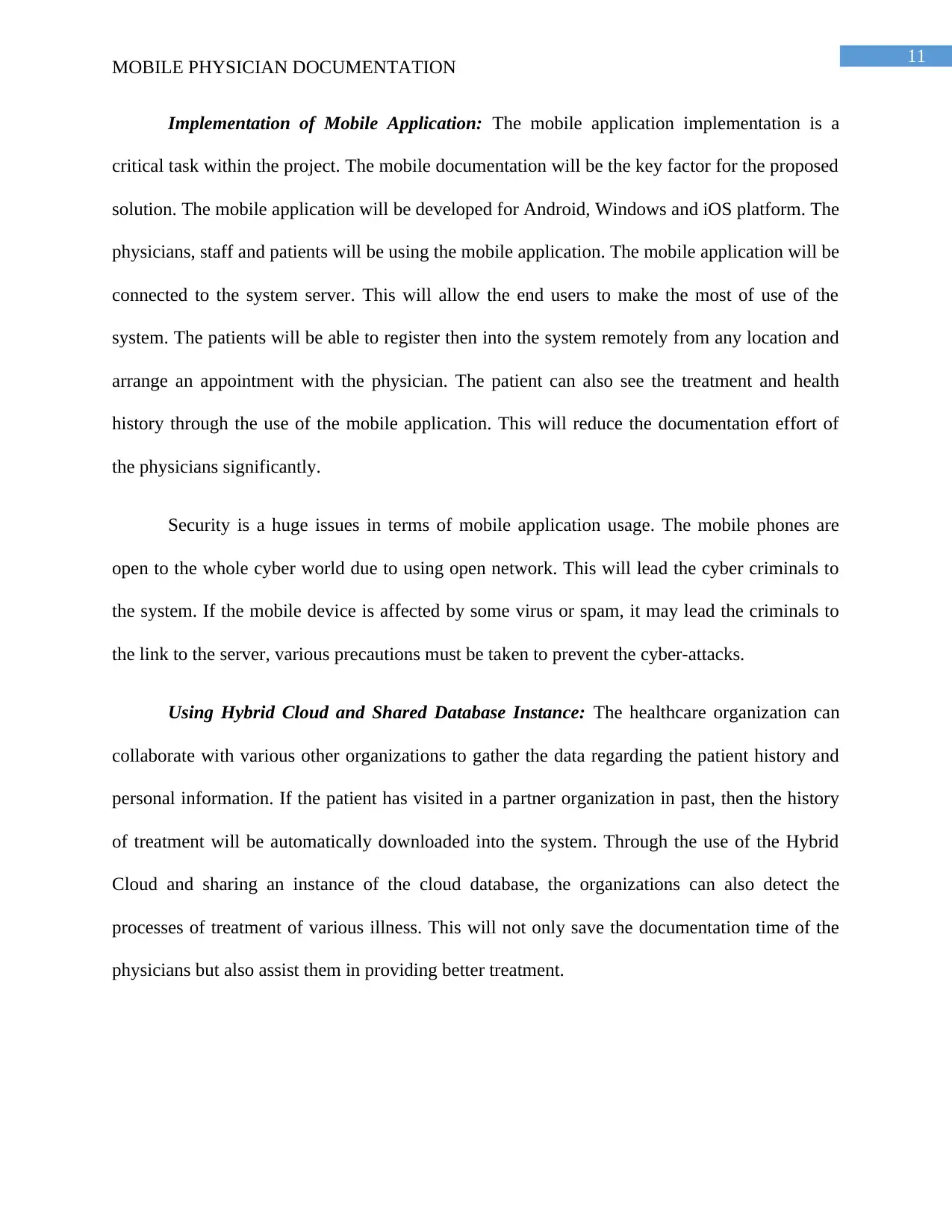
11
MOBILE PHYSICIAN DOCUMENTATION
Implementation of Mobile Application: The mobile application implementation is a
critical task within the project. The mobile documentation will be the key factor for the proposed
solution. The mobile application will be developed for Android, Windows and iOS platform. The
physicians, staff and patients will be using the mobile application. The mobile application will be
connected to the system server. This will allow the end users to make the most of use of the
system. The patients will be able to register then into the system remotely from any location and
arrange an appointment with the physician. The patient can also see the treatment and health
history through the use of the mobile application. This will reduce the documentation effort of
the physicians significantly.
Security is a huge issues in terms of mobile application usage. The mobile phones are
open to the whole cyber world due to using open network. This will lead the cyber criminals to
the system. If the mobile device is affected by some virus or spam, it may lead the criminals to
the link to the server, various precautions must be taken to prevent the cyber-attacks.
Using Hybrid Cloud and Shared Database Instance: The healthcare organization can
collaborate with various other organizations to gather the data regarding the patient history and
personal information. If the patient has visited in a partner organization in past, then the history
of treatment will be automatically downloaded into the system. Through the use of the Hybrid
Cloud and sharing an instance of the cloud database, the organizations can also detect the
processes of treatment of various illness. This will not only save the documentation time of the
physicians but also assist them in providing better treatment.
MOBILE PHYSICIAN DOCUMENTATION
Implementation of Mobile Application: The mobile application implementation is a
critical task within the project. The mobile documentation will be the key factor for the proposed
solution. The mobile application will be developed for Android, Windows and iOS platform. The
physicians, staff and patients will be using the mobile application. The mobile application will be
connected to the system server. This will allow the end users to make the most of use of the
system. The patients will be able to register then into the system remotely from any location and
arrange an appointment with the physician. The patient can also see the treatment and health
history through the use of the mobile application. This will reduce the documentation effort of
the physicians significantly.
Security is a huge issues in terms of mobile application usage. The mobile phones are
open to the whole cyber world due to using open network. This will lead the cyber criminals to
the system. If the mobile device is affected by some virus or spam, it may lead the criminals to
the link to the server, various precautions must be taken to prevent the cyber-attacks.
Using Hybrid Cloud and Shared Database Instance: The healthcare organization can
collaborate with various other organizations to gather the data regarding the patient history and
personal information. If the patient has visited in a partner organization in past, then the history
of treatment will be automatically downloaded into the system. Through the use of the Hybrid
Cloud and sharing an instance of the cloud database, the organizations can also detect the
processes of treatment of various illness. This will not only save the documentation time of the
physicians but also assist them in providing better treatment.
⊘ This is a preview!⊘
Do you want full access?
Subscribe today to unlock all pages.

Trusted by 1+ million students worldwide
1 out of 24
Related Documents
Your All-in-One AI-Powered Toolkit for Academic Success.
+13062052269
info@desklib.com
Available 24*7 on WhatsApp / Email
![[object Object]](/_next/static/media/star-bottom.7253800d.svg)
Unlock your academic potential
Copyright © 2020–2025 A2Z Services. All Rights Reserved. Developed and managed by ZUCOL.





